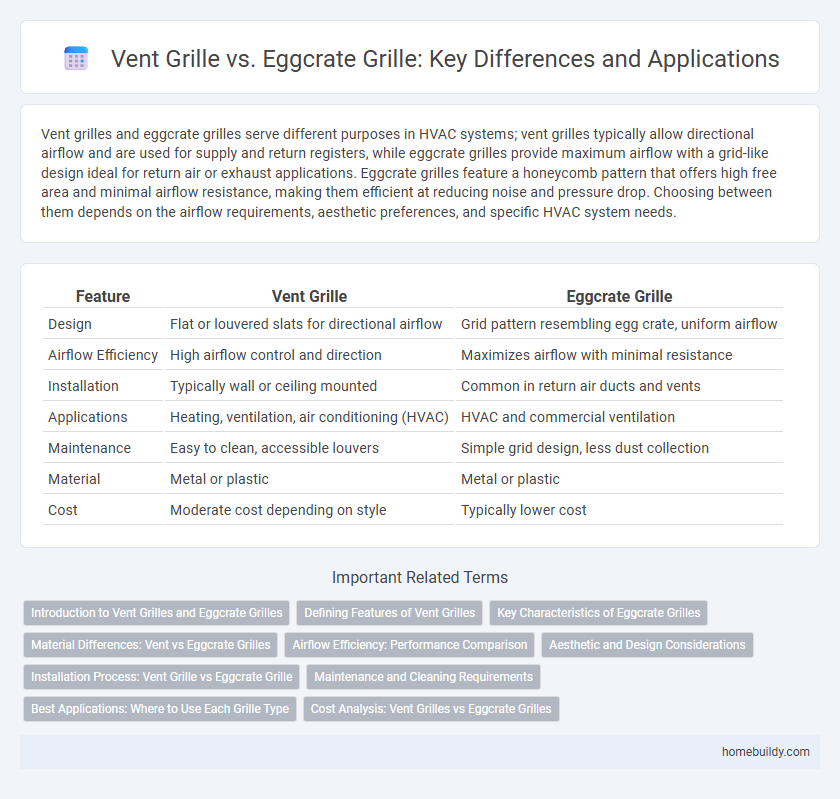Vent grilles and eggcrate grilles serve different purposes in HVAC systems; vent grilles typically allow directional airflow and are used for supply and return registers, while eggcrate grilles provide maximum airflow with a grid-like design ideal for return air or exhaust applications. Eggcrate grilles feature a honeycomb pattern that offers high free area and minimal airflow resistance, making them efficient at reducing noise and pressure drop. Choosing between them depends on the airflow requirements, aesthetic preferences, and specific HVAC system needs.
Table of Comparison
| Feature | Vent Grille | Eggcrate Grille |
|---|---|---|
| Design | Flat or louvered slats for directional airflow | Grid pattern resembling egg crate, uniform airflow |
| Airflow Efficiency | High airflow control and direction | Maximizes airflow with minimal resistance |
| Installation | Typically wall or ceiling mounted | Common in return air ducts and vents |
| Applications | Heating, ventilation, air conditioning (HVAC) | HVAC and commercial ventilation |
| Maintenance | Easy to clean, accessible louvers | Simple grid design, less dust collection |
| Material | Metal or plastic | Metal or plastic |
| Cost | Moderate cost depending on style | Typically lower cost |
Introduction to Vent Grilles and Eggcrate Grilles
Vent grilles are designed for airflow regulation and aesthetic covering of HVAC openings, offering various styles that balance air distribution and visual appeal. Eggcrate grilles feature a grid pattern resembling an egg crate, maximizing airflow efficiency while providing a sturdy frame ideal for both supply and return air applications. Choosing between vent grilles and eggcrate grilles depends on specific ventilation needs, airflow requirements, and the desired look for the installation area.
Defining Features of Vent Grilles
Vent grilles feature adjustable louvers that regulate airflow direction and volume, offering precise ventilation control. Their design typically includes a frame with parallel slats, optimized for both functionality and aesthetic integration into walls or ceilings. Unlike eggcrate grilles, which have a grid-like pattern primarily for air distribution, vent grilles emphasize airflow modulation and directional control.
Key Characteristics of Eggcrate Grilles
Eggcrate grilles feature a grid-like pattern of evenly spaced squares, allowing for higher airflow rates compared to traditional vent grilles. Their design provides superior air distribution and minimal airflow resistance, making them ideal for HVAC systems requiring efficient ventilation. Constructed from materials such as aluminum or steel, eggcrate grilles offer durability and ease of maintenance in both commercial and residential applications.
Material Differences: Vent vs Eggcrate Grilles
Vent grilles are commonly made from aluminum or steel, offering durability and corrosion resistance for HVAC applications, while eggcrate grilles often utilize lighter materials such as expanded metal or plastic for ease of installation and cost efficiency. The solid frame of vent grilles provides structural strength and better support for filters, whereas eggcrate grilles feature a grid pattern that maximizes airflow but may compromise on rigidity. Material selection impacts factors like longevity, maintenance, and suitability for environments requiring robust performance or lightweight design.
Airflow Efficiency: Performance Comparison
Vent grilles typically offer more uniform airflow distribution compared to eggcrate grilles, which can cause turbulence and reduce overall efficiency due to their grid pattern. The open area percentage in vent grilles usually exceeds that of eggcrate grilles, allowing higher cubic feet per minute (CFM) airflow with lower static pressure drop. Performance tests indicate vent grilles provide up to 15% better airflow efficiency, making them more effective for HVAC systems aiming to optimize ventilation and energy consumption.
Aesthetic and Design Considerations
Vent grilles offer a sleek, minimalist appearance with straight, evenly spaced slats that complement modern and contemporary interiors, enhancing overall aesthetics. Eggcrate grilles feature a grid pattern with small, square openings that provide a more industrial or utilitarian look but may appear bulkier in residential settings. Choosing between vent grilles and eggcrate grilles depends on design goals, with vent grilles favoring refined visual appeal and eggcrate grilles focusing on maximizing airflow efficiency.
Installation Process: Vent Grille vs Eggcrate Grille
The installation process of a vent grille typically involves securing the unit to the duct or wall opening using screws or clips, ensuring an airtight fit and easy access for maintenance. Eggcrate grilles, with their lightweight and simple grid design, often allow for quicker installation as they can be mounted directly onto ceilings or walls with minimal hardware. Choosing between the two depends on the specific airflow control needs and installation environment, as vent grilles provide more precise airflow direction while eggcrate grilles excel in easier, faster setups.
Maintenance and Cleaning Requirements
Vent grilles typically feature flat or slightly curved slats that collect less dust and debris, making routine maintenance and cleaning easier compared to eggcrate grilles, which have a grid-like pattern that traps more particles and requires more frequent and detailed cleaning. The simpler design of vent grilles allows for quicker wiping or vacuuming, reducing the time and effort needed for upkeep. Eggcrate grilles often demand disassembly or specialized tools to thoroughly clean trapped dirt, increasing maintenance complexity.
Best Applications: Where to Use Each Grille Type
Vent grilles offer precise airflow control suitable for HVAC systems in residential and commercial buildings, providing efficient ventilation and noise reduction. Eggcrate grilles feature a grid-like design ideal for return air applications and suspended ceilings, enhancing air distribution without obstructing airflow. Selecting vent grilles for supply vents and eggcrate grilles for return or exhaust vents maximizes system performance and energy efficiency.
Cost Analysis: Vent Grilles vs Eggcrate Grilles
Vent grilles typically offer a lower upfront cost compared to eggcrate grilles, making them a budget-friendly option for HVAC applications. Eggcrate grilles, while slightly more expensive, provide enhanced airflow control and durability, which can translate into long-term energy savings and reduced maintenance costs. Choosing vent grilles is ideal for cost-sensitive projects, whereas eggcrate grilles may deliver better overall value through improved performance and longevity.
vent grille vs eggcrate grille Infographic

 homebuildy.com
homebuildy.com